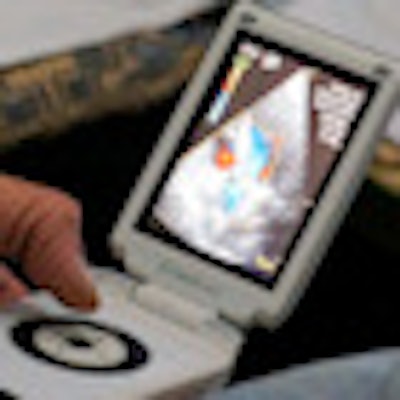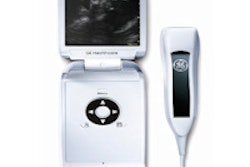
Is the widespread adoption of compact ultrasound systems by other medical specialties undermining radiology's control of this modality? And if so, does anyone in radiology care? AuntMinnie.com explores these questions in a two-part series.
While compact ultrasound's proliferation into other areas of medicine has induced hand-wringing in the radiology ultrasound community, ultrasound just isn't a top priority for many radiology practices today, a recent panel session found.
In a controversy session at RSNA 2012, a panel of ultrasound luminaries explored the question of whether compact ultrasound systems are a threat to radiology, and if so, how the specialty can respond. Dr. Myron Pozniak, a professor of radiology and chief of body CT at the University of Wisconsin School of Medicine and Public Health, served as moderator for the session.
Disruptive technology?
By definition, disruptive technology is simpler, cheaper, often lower-end, and may be more convenient to use. It's not necessarily as good as the higher-end equipment, but it's good enough, Pozniak said.
It also meets the functional requirements of a small segment of the market for which the existing technology is overkill, and it disrupts the business model of the incumbent.
"And in this case, [radiologists] are the incumbent," he said. "The issue is: How should we respond?"
The number of compact ultrasound manufacturers has been rapidly increasing in recent years. According to figures from Klein Biomedical Consultants, there were three suppliers in 2000 and nine as of 2005. In 2012, there were at least 23, said Dr. John McGahan, a professor of radiology and vice chair and director of abdominal imaging at the University of California, Davis Medical Center.
The number of clinical applications for compact ultrasound is also growing. One manufacturer cites applications including anesthesia, critical care, focused echocardiography, ob/gyn, cardiovascular disease management, emergency medicine, peripherally inserted central catheters, internal medicine, musculoskeletal, vascular, and surgery, McGahan said.
Compact ultrasound systems now make up nearly half of ultrasound equipment unit sales in the U.S., McGahan said.
Make ultrasound, not war
Rather than fighting turf wars to prevent utilization of ultrasound by other specialties, collaborating with other departments can yield a lot of value, according to McGahan. At his institution, ultrasound training is managed jointly by the obstetrics and radiology departments. Credentialing is provided by the individual departments.
"We work together on a daily basis," he said.
All scans meet equal standards, and all images are stored and available on the same PACS; interpretations are available on the PACS and electronic medical record, he said. Billing is tracked and reimbursement is distributed to those interpreting the scans. Joint continuous quality improvement (CQI) is performed, and mutual respect has developed between the two departments, according to McGahan.
This collaborative approach offers a number of advantages, including universal availability of data and images, he said. Ultrasound is performed and interpreted extemporaneously, and images are available for follow-up and review. In addition, imaging is performed to jointly accepted standards and exams, and there is no duplication of studies.
Emergency department (ED) ultrasound is covered by the radiology department. A sonographer is available 24/7 and ED cases have a five-minute priority. All images are stored in PACS for review, and follow-up exams are also stored in PACS for comparison and CQI, he said. In addition, all images are available for publication.
"We work together and we publish [papers] together," he said.
In the future, McGahan expects continued growth in the compact ultrasound market and more ultrasound education. But radiologists still have an important role to play.
"I do believe that we are still going to be around; people are still going to ask for an ultrasound of record," he said. "And we are going to do the ultrasound of record."
In addition, collaborative efforts with ultrasound may be locally driven in the future. Continued use and growth of ultrasound by other specialties will also likely take place, he said.
Radiologists losing interest?
Many specialties today think they can perform ultrasound, and the number of clinicians working with the modality continues to grow rapidly. At the same time, radiologists are working feverishly to maintain their income, said Dr. John Cronan, chairman of diagnostic imaging at Brown University's Alpert Medical School and Rhode Island Hospital.
A skewed payment system awards much higher reimbursement for MRI and CT compared to ultrasound, and the growth of outpatient imaging centers and their controlled hours appeal to radiologists, he said. Furthermore, MRI and CT have experienced significant technology advances, while there haven't been many technological gains with ultrasound, Cronan said.
"We keep talking about [ultrasound] contrast media and how it's revolutionized things, but we've been talking about that since the last century," he said.
Compact ultrasound appeals to nonradiologists, and their use of ultrasound has received support from the American Medical Association (AMA). In a 2004 policy statement, the AMA said that ultrasound imaging is within the scope of practice of appropriately trained physicians. The AMA also actively opposes any attempt by regulatory bodies to restrict reimbursement for imaging procedures based on physician specialty, Cronan said.
Faced with decreasing reimbursement, radiologists are being driven to focus more on high-end imaging procedures that are rich in relative value units (RVUs).
"This leaves ultrasound as sort of the stepchild," he said. "The driver of your income level is certainly not ultrasound in a radiology practice."
Vendor sales tactics are also contributing to this trend. Companies are marketing directly to nonradiologists and can provide turnkey operations covering leasing, installation, training, billing, service, and marketing.
"This has caused more dispersion of imaging," he said.
In addition, few residents are pursuing ultrasound fellowships. Training programs lack ultrasound experts, and there's less focus on ultrasound training.
Another factor is the fusion of imaging into other specialties. Imaging has become integral to the practice of medicine, Cronan said.
"PACS, teleradiology, and the Web have made imaging a commodity," he said.
Adoption of service-line imaging, such as when a new cancer center includes imaging services, is another factor in the dispersion of imaging away from its traditional home in the radiology department.
In general, the combination of the following issues results in a perfect storm, according to Cronan:
- A lack of interest in ultrasound by radiology
- Interest in self-referral by nonradiologists
- Availability of compact ultrasound that is inexpensive and easy to use
- Lack of trained technologists
- Stagnant ultrasound technology
- Relatively poor reimbursement
- Acceptance of ultrasound as the "new stethoscope"
- The commoditization of imaging
A Canadian perspective
The Canadian Association of Radiologists (CAR) is worried about point-of-care ultrasound. Its main worry is not so much that everyone else is interested in ultrasound, but that radiologists aren't interested, said Dr. Peter Cooperberg, an independent medical practice professional from Vancouver, Canada.
"If the young radiologists stop doing it, that's when other [physicians] are going to start doing it, because a lousy ultrasound done by somebody else is not much worse than a lousy ultrasound being done by radiology," he said.
CAR has a working group on point-of-care ultrasound for the Royal College of Physicians and Surgeons of Canada, which is the accreditation group for Canadian physicians.
"The question is: If somebody else is going to be doing it with very little training, is their training adequate, and should there be a safeguard for patients?" he said.
Work is just beginning on that effort.
To determine the prevalence of compact ultrasound in Canada and in which hospital departments, Cooperberg emailed a survey to 12 Canadian academic medical centers in 2012. There were nine respondents, and the results revealed the adoption of compact ultrasound by different clinical services:
- Emergency department: 9/9
- Intensive care unit: 7/9
- Obstetrics: 9/9
- Trauma surgery: 3/9
- Urology: 3/9
- Nephrology: 3/9
- Anesthesia: 4/9
- Endocrine (ENT): 4/9
- Rheumatology: 2/9
- Angiography: 9/9
- Family practice: 0/9
While some think family practice physicians would be natural candidates to use compact ultrasound, Cooperberg doesn't believe that will be the case. General practitioners (GPs) are very busy, and, especially in Canada, they are focused on trying to keep up with throughput.
"I don't think it's going to be a problem for GPs and people having it in their office, except for specialists who have some good reason to do it," he said. "And they're not taking cases away from us; they're really not going to be doing diagnostic [ultrasound], especially because they can't get paid for it."
The one exception to that situation is in Ontario, where emergency physicians can bill for -- and actually get paid more for -- an abdominal ultrasound than a radiologist. As for the rest of Canada, only obstetricians, radiologists, cardiologists, and vascular surgeons who have six months of ultrasound training can bill for ultrasound, according to Cooperberg.
Part 2 of AuntMinnie.com's coverage of the compact ultrasound controversies session will highlight ultrasound training, musculoskeletal ultrasound, and an outsider's view on whether compact ultrasound is really a threat to radiology.




















